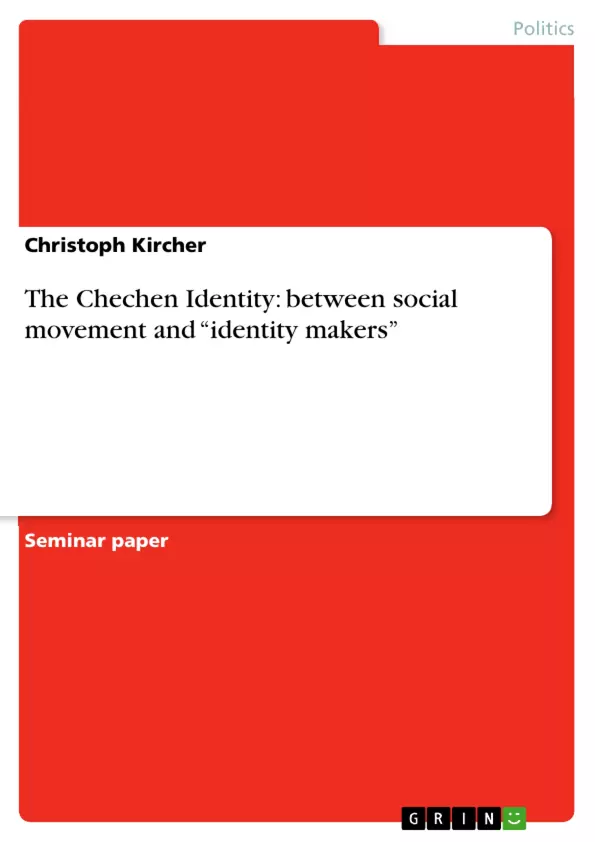The objective of this research paper was to distinguish between two patterns with which Chechen identity has been constructed until now. On the one hand it has shown that identity is constructed by discursive social practice. On the other hand identity is shaped by narrations, which re- arrange hi[stories] in a given time period, and political discourses. The analysis of the latter one has shown that identity “from above” (identity-makers) bears the risk of being exploited as legitimation for specific goals. Finally I have compared the results of this research with Huntington’s famous thesis of “Clash of Civilizations”, with the result that the Chechen conflict cannot be incorporated in a broader conflict, such as “Clash of Civilizations” because of Chechens peculiar cultural composition.
Inhaltsverzeichnis (Table of Contents)
- Introduction
- I. Collective identity as social product: Chechen tradition
- (1) Gemeinwesen, mountain democracy and the “adat law”
- (2) Collective identity as discourse: Chechen honour
- (3) Gender performativity in Chechen tradition
- II. Narration and Discourse: “Identity makers”
- (1) Iman Shamil and the North-Caucasian Emirate
- (2) Construction of identity from above: a political discourse
- Conclusion
Zielsetzung und Themenschwerpunkte (Objectives and Key Themes)
This research paper aims to differentiate between two patterns of constructing Chechen identity. It examines how identity is formed through discursive social practices and how it is shaped by narratives and political discourses. The paper analyzes the risks associated with “identity-makers” and how they can be exploited for specific goals. Finally, it compares the findings to Huntington's thesis of the "Clash of Civilizations" to demonstrate that the Chechen conflict cannot be categorized as part of a broader clash of civilizations due to the unique cultural composition of Chechens.
- The construction of Chechen identity through social practices and discourses.
- The role of narratives and “identity-makers” in shaping Chechen identity.
- The dangers of exploiting identity for political gain.
- The unique cultural composition of Chechens and their relationship to the “Clash of Civilizations” thesis.
Zusammenfassung der Kapitel (Chapter Summaries)
The introduction of this research paper sets the stage by introducing the Chechen conflict and its historical context. It highlights the complexity of the conflict, its roots in the declaration of independence by the Chechen government under Dudajew, and the subsequent wars with Russia. It also discusses the role of media manipulation and the Russian government’s attempt to portray the conflict as a clash of civilizations between the modern world and the backward Islamic world.
Chapter I delves into the social product of Chechen identity, exploring its construction through tradition. This chapter begins by outlining the principles of "Gemeinwesen" (community), mountain democracy, and the "adat law" that formed the foundation of Chechen society. The "adat law," a customary law, ensured a framework of mutual relations within the community, serving as a significant influence on collective identity formation.
The chapter then explores the importance of honor ("yakh") as a discursive construct within Chechen society. It highlights how this social benchmark shaped individuals' and communities' sense of self, and how it played a role in the formation of Chechen anti-authoritarian mentality.
Finally, the chapter delves into the role of gender performativity in Chechen tradition. It examines how societal expectations and cultural norms shaped the roles of men and women in the community, further contributing to the formation of Chechen identity.
Chapter II shifts focus to the role of narratives and discourses in shaping Chechen identity. It begins by analyzing the narrative of Iman Shamil, a significant figure in Chechen history. The chapter explores how this narrative is used to create a sense of historical community and justify the establishment of a theocratic state. It also discusses the shortcomings of Shamil's rule and how some Chechen communities opposed his authoritarian regime.
The chapter concludes by examining the political discourse surrounding Chechen rebels, analyzing how they have been portrayed as terrorists and fundamentalists by the Russian government. It discusses how the Russian media and politicians emphasized Islamic attributes and distorted the realities of the Chechen conflict to legitimize their actions.
Schlüsselwörter (Keywords)
The core keywords and focus topics of this research paper include Chechen identity, discursive social practice, narratives, "identity-makers", political discourse, "Clash of Civilizations", adat law, honor ("yakh"), gender performativity, Iman Shamil, North-Caucasian Emirate, Wahhabism, and terrorism. These keywords encapsulate the key concepts and research areas explored in the text.
- Quote paper
- Christoph Kircher (Author), 2009, The Chechen Identity: between social movement and “identity makers” , Munich, GRIN Verlag, https://www.grin.com/document/166073



